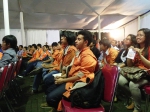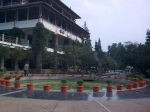ORCA: the Innovation that Propels Team Atyasa Bramantya to National Runner-Up in Technology Development (Airframe Innovation) at KRTI 2023
By Anggun Nindita
Editor Anggun Nindita

BANDUNG, itb.ac.id — Institut Teknologi Bandung (ITB) Student Activity Unit (UKM) Aksantara won won 6 championship titles and 1 best strategy award at the 2023 Indonesian Flying Robot Contest (KRTI) in Lampung which finished on September 27 2023.. One of these achievements was achieved by the Atyasa Bramantya Team who competed in the Technology Development (Airframe Innovation) category.
“The design principle of our airplane was inspired by the Sikorsky S-64 Skycrane which possessed a flexible cargo room, Boeing-Vertol MV-22 Osprey with a tiltrotor feature and a Prandtl plane that has a box wing planform. The combination of all three inspired us to conceptualize ORCA (Outreach Cargo Aircraft) which can be relied on in difficult terrain, especially disaster-affected areas. Disaster management can be controlled with only one type of airframe, and its operational cost will also become cheaper,” stated the head of the team, Djoko Bayu Murtie (Aerospace Engineering, 2021).
This innovation was inspired by the recent prevalence of natural disasters in Indonesia during the past three years. However, the availability and responsiveness of emergency and rescue services in Indonesia is still very limited. The viable rescue period (golden time) lasts for only an hour, which has been proved to be critical. After passing the golden period, the number of casualties will increase significantly.

ORCA is equipped with a picatinny rail system, usually found in artillery systems. With a few modifications, ORCA could be deployed on various missions, including baggage transport of up to 2 kg weight.
“There is also a hardpoint carabiner, which functions as a hook and is able to carry baggage with a size larger than the plane’s body. ORCA also possesses a winch/crane and parachute-assisted delivery (PAD) mechanism to drop medical supplies and clothing,” Oscha Luthfiano Akmar (Aerospace Engineering, 2021) explained.
ORCA’s wing is box wing shaped with two wings, front and back, linked by a wing connector on each of its ends. Djoko also mentioned that the wings’ surface area influenced their lift. “The length of ORCA’s frame is measured to be 1.7 m and its wingspan 1.5 m. To be ideal with the large weight of ORCA, it requires proportionally huge wings as well. The size also became more compact with two wings,” he explained to the reporter from ITB Public Relations, Saturday (07/10/2023).
The team developed a tilt-rotor design with moveable machines, up above like a helicopter, upfront like a normal wing. The concept combined helicopters’ VTOL (Vertical Take Off and Landing) ability with the speed and reach of conventional planes. ORCA is also furnished with a Thrust Vector Control (TVC) so that it has an improved maneuvering and control ability, as well as restriction in its turning radius. The device could take-off and land from a narrow 2 x 2.5 m square-shaped room.

ORCA’s strong point is its huge lifting force which decreases the plane’s drag force due to its design. The material is composed of Carbon Fiber Reinforced Polymer Composites (CRFP) composite, the material used for Boeing 787 Dreamliner, combined with a few other materials arranged in a layered and laminated structure.
Inarguably, the construction of such a complex UAV required synergy from various fields of knowledge. The team was reinforced by 25 members from Aerospace Engineering, Electrical Engineering, Mechanical Engineering, Chemical Engineering, and Materials Engineering. They prepared for the competition under the guidance of Dr. Yazdi Ibrahim Jenie, S.T., M.T.
Achieving the award was not simple with the limited amount of time given. During the regional selection, buckling occurred and their UAV crashed down, thus they had to redesign it again in terms of structure and manufacture. The system was also improved to amplify its power and machine. In 3 weeks, they succeeded in finishing a more complex airframe with its real dimension and one dummy scale for testing. During the competition, they were hurdled with a wind of 15 knots in speed, signified by the windsock’s horizontal flutter nearby the flight area.
Djoko admitted his enjoyment throughout the series of competition. Even though he found it to be difficult and exhausting, he had the opportunity to implement the knowledge he learned in class, not only from his major but also from various disciplines.
"At the end of the interview session, Oscha conveyed his message, “As a team, we must work well and set aside our egos. It takes a strong fighting spirit to achieve the best results. Hopefully, the mistakes made this year won't be repeated, and next year, we can aim for first place,” he stated.
Reporter: Maharani Rachmawati Purnomo (Oceanography, 2020)
Editor: M. Naufal Hafizh
Translator: Firzana Aisya (Bioengineering, 2021)
Editor: Hanna Daniela Ayu (Aerospace Engineering, 2021)

.jpg)
.jpg)
.png)
.jpg)
.jpg)



